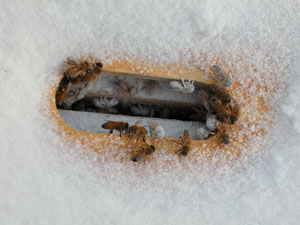 You've seen me going on and one about the two main winter beekeeping issues around here: food stores and mites. This is the most interesting picture I could show you about how I've been trying to look after both.
You've seen me going on and one about the two main winter beekeeping issues around here: food stores and mites. This is the most interesting picture I could show you about how I've been trying to look after both.This is a peek through the inner cover of the Wilde colony on my roof. The bees inside are covered in powdered sugar, and the cover itself is holding about 4 pounds of granulated cane sugar. The powdered sugar is a non-toxic mite control method: the varroa mites seem to be unable to hang onto powdered bees, and they fall off (hopefully leaving the lives of the bees altogether). The bees soon clean themselves off, and get a bit of a snack in the bargain. MaryEllen (the beekeeper, not the colony) points out that this method is kind of like flossing your teeth, though: you need to do it over and over to get much benefit.
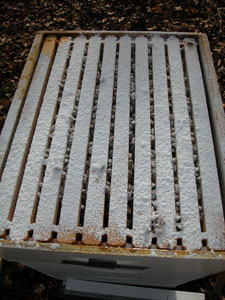 Very soon after sugaring up the bees, white-covered bees began emerging from the hive entrances, though this is just a close up from the top of a hive. To properly apply the sugar, you should remove each box, powder the top, place the next box on top, powder it, and so on. I am afraid to manipulate the bees much in cold weather: I could break the cluster, or expose the queen, or do some other typically awkward thing at a time when the bees have few options. So, for the sake of doing something, I put on the powder and then made another oxalic acid application.
Very soon after sugaring up the bees, white-covered bees began emerging from the hive entrances, though this is just a close up from the top of a hive. To properly apply the sugar, you should remove each box, powder the top, place the next box on top, powder it, and so on. I am afraid to manipulate the bees much in cold weather: I could break the cluster, or expose the queen, or do some other typically awkward thing at a time when the bees have few options. So, for the sake of doing something, I put on the powder and then made another oxalic acid application. 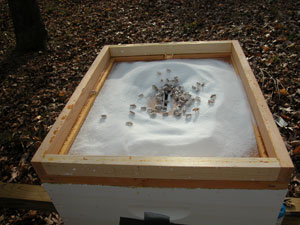 The granulated sugar is a winter feeding method suggested by a beekeeper at the state meeting last month. Bees often stop taking sugar syrup when the temperature reaches freezing, but they will (apparently) creep up on the inner cover and grab some dry sugar when the need arises. You can put a shim on top of the cover, and then place the telescoping cover. I'm a little unsure of whether this is worthwhile, for a couple of reasons. The first is that I don't personally know any beekeeper who does this, and the second is that the bees will need some source of liquid water in order to access the sugar as a food source. This latter is also a concern when offering them fondant (bee candy), however, and I know that they take fondant just fine.
The granulated sugar is a winter feeding method suggested by a beekeeper at the state meeting last month. Bees often stop taking sugar syrup when the temperature reaches freezing, but they will (apparently) creep up on the inner cover and grab some dry sugar when the need arises. You can put a shim on top of the cover, and then place the telescoping cover. I'm a little unsure of whether this is worthwhile, for a couple of reasons. The first is that I don't personally know any beekeeper who does this, and the second is that the bees will need some source of liquid water in order to access the sugar as a food source. This latter is also a concern when offering them fondant (bee candy), however, and I know that they take fondant just fine.As an example, here are two pictures of fondant. The first is a flower-shaped (broken) brick of bee candy newly placed on the Cockrill hive at the mill. The second is a picture of a brick of fondant MaryEllen put on the neighboring Millard hive a week or so before. Chew chew chew!
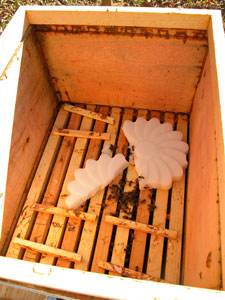
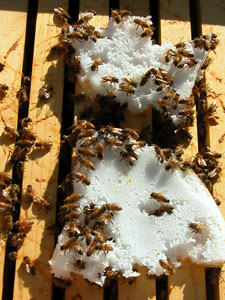
At the state meeting, the most experienced beekeepers agreed about one thing, as winter approaches: after 100 million years, bees don't freeze to death during winter, they starve. We've had warm temperatures, and I have seen bees flying almost every day and only the rarest of flowers in bloom. Though applying the oxalic acid to save the bees from mites will require 15 unique applications, it appears that far more of my time will be spent this year dishing out the sugar.
3 comments:
Just for recordkeeping, today I put a gallon and a half of 2-1 sugar water on Twain, because they are truly, scary light on stores. This AM, when I peeked in to place just a couple of quarts of food, all the girls were clustered near the top. Not good. I probably should not have harvested any honey from them this year after all. Wilde weighs in heavier, but I will feed them next time, too.
I also applied oxalic acid to both Wilde and Twain. It gave me a chance to watch the workers coming in. Their baskets are absolutely PACKED with pollen. There is the light creamy kind that looks like early Spring willow, and bold yellow like I saw off of the later Summer aster. Walking the neighborhood, I see chickweed, henbit, and rosemary to which they could be going. I wish it would cool down so they would stop flying and sip their stores more slowly.
OK, so at the Monastery, the girls have eaten more than half the dry sugar they received (the stuff in the second picture, above). They also received their last application of oxalic, for now. I'm thinking of using formic in the Spring (since it is good karma to vary your treatments).
They had cleared away most of the powdered sugar, with a lot of it ending up on the bottom boards. They have a significant mite drop, too, though that is typical during treatment, and they still have far less than any of the other colonies. All in all, the healthiest bees in my worls are at the Franciscan Monastery. Talk abotu good creature karma!
Thank you,for your information
Post a Comment